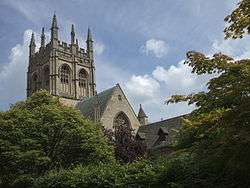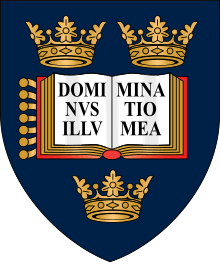Merton College Chapel
Merton College Chapel is the church of Merton College, Oxford, England. Dedicated to St Mary and St John the Baptist, the chapel was largely completed in its present form by the end of the 13th century. The building retains a number of original stained glass windows, and is noted for its acoustics. A choral foundation was established in 2008 by Peter Phillips.
| Merton College Chapel, Oxford | |
|---|---|
 Merton College Chapel viewed from Grove Walk. | |
| Location | Merton College, Oxford, England |
| Country | United Kingdom |
| Denomination | Church of England |
| Website | Official website |
| History | |
| Founder(s) | Walter de Merton |
| Dedication | St Mary and St John the Baptist |
| Architecture | |
| Style | Gothic |
| Groundbreaking | c1290 |
| Completed | 1294 (choir) transepts (1424–5) tower 1448–51 |
| Administration | |
| Diocese | Oxford |
| Clergy | |
| Chaplain(s) | Rev. Dr. Simon Jones |
| Laity | |
| Director of music | Benjamin Nicholas & Peter Phillips |
History
13th century origins
On 13 September 1266 the church of St John the Baptist was granted to the scholars of Merton College by the Abbey of Reading.[1] However, by the late 1280s it had fallen into "a ruinous condition",[2] and Merton college accounts show that work on a new church on the same site began in about 1290.
The present choir with its enormous east window was complete by 1294. The window is an important example (because it is so well dated) of how the strict geometrical conventions of the Early English Period of architecture were beginning to be relaxed at the end of the 13th century.[3]
Unusually for an English religious building, much medieval glass survives intact. Of the seven pairs of windows in the side walls of the Quire, twelve retain original 13th century glass, set in Decorated tracery. The glass was donated to the Chapel sometime between 1289 and 1296 by Henry Mansfield. The scene of the Annunciation in the East Window also dates from the late 13th century.[4]
14th century
The south transept was built in the 14th century, the north transept in the early years of the 15th century. The great tower was complete by 1450. The chapel replaced the parish church of St. John and continued to serve as the parish church as well as the chapel until 1891. Because of this, it is generally referred to as Merton Church in older documents, and there is a north door into the street as well as doors into the college. This dual role also probably explains the enormous scale of the chapel, which in its original design was to have a nave and two aisles extending to the west.[5]
16th century and Reformation

In the early 16th century, the college appears to have abandoned plans to extend the chapel, as the land on which the nave would have been built was leased in 1517 to Richard Foxe (c. 1448–1528), Bishop of Winchester, founder of Corpus Christi College, next door to Merton.[4] The lecturn, one of the finest examples of its kind, dates from the pre-Reformation era; it was a gift from John Martock in 1504.[4]
The Reformation did not leave Merton Chapel untouched. During the reign of the zealously Protestant Edward VI (1547–1553), traditional forms of worship began to change, and it was most likely at this time that the medieval stained glass was removed or hidden. The glass in the chancel windows, for example, was protected by being boarded over and whitewashed.[6] The wall paintings behind the stalls were also saved at this time, though they would not survive the next century, being destroyed in 1651 "to the sorrow of curious men that were admirers of ancient painting".[6] The Edwardian reforms also saw the removal from the Chapel of the traditional service books, vestments, furnishings, and images, all considered offensive to the new religion.[6]
King Edward died young, and during the reign of his sister Mary I (1553–1558) Catholicism was restored, and enthusiastically embraced by the college. Soon afterwards, under Elizabeth I, Protestantism was once again enforced and Merton College found itself facing a siege by Elizabeth's Archbishop of Canterbury, Matthew Parker, for three weeks, in defence of the old religion.[4]
17th century
The church was in a bad physical state by the 17th century. We do not know when the Medieval glass of the transepts and the lower part of the Great East Window were broken, but this seems to have taken place between 1646 and 1655. [7] In any event, by 1634 the building was in considerable disrepair, and the decision was taken to replace the medieval floor tiles with black and white marble. [8]In 1655 the roof of the South Transept roof collapsed, damaging many of the medieval monuments.[4] This led to a number of rebuilding projects by architects including Christopher Wren and Edward Blore. In 1671 Wren was instructed to install a new screen at the then considerable cost of £1,130, as well as stalls carved in the classical style.[4]
20th century
During World War II the ancient stained glass was removed from the chapel windows to protect it from enemy bombs; the glass was stored in a vault under the New Bodleian Library.[9] On 23 January 1967 Fr Michael Hollings celebrated the first Roman Catholic Mass to have been held in the chapel since the Reformation. [10]
Modern era

A new choral foundation was established in 2008 when Peter Phillips and Benjamin Nicholas were appointed Directors of Music. The College Choir consists of twenty-eight singers, of whom eighteen are choral scholars; there are also two organ scholars. The choir has toured in France (2009 and 2010), in the USA (2011) and in Sweden (2013) and features prominently during Merton's annual festival Passiontide at Merton. The choir's repertoire includes a number of pieces written for it by Howard Skempton, Gabriel Jackson and John Tavener. The college celebrated its 750th anniversary in 2014, when the Merton Choirbook was premiered.
The College also recently commissioned a new organ to be installed, to coincide with the anniversary celebrations. The organ was built by Dobson Pipe Organ Builders from Lake City, Iowa and arrived in August 2013. It was officially opened at the Organ Festival weekend in April 2014.
A spire from the chapel has resided in Pavilion Garden VI of the University of Virginia since 1928, when "it was given to the University to honor Jefferson's educational ideals".[11]
Gallery
 Merton College from Christ Church Meadow
Merton College from Christ Church Meadow- Merton College (including chapel) viewed from the north from St Mary's Church
 The interior of the chapel from under the tower, looking towards the roof, with the former organ on the left
The interior of the chapel from under the tower, looking towards the roof, with the former organ on the left Late 18th or early 19th Century aquatint by James Merigot
Late 18th or early 19th Century aquatint by James Merigot.jpg) Merton College Chapel viewed from Front Quad
Merton College Chapel viewed from Front Quad
See also
- Merton College Library
- Mob Quad at Merton
References
- Henderson, Bernard William, p.26, Merton College, (1899). Retrieved 9 February 2010
- Anthony Wood, quoted in Bott, p.24
- Pevsner, p.25
- History of Merton College Chapel. Retrieved 16 July 2020.
- See Bott, pp.24–37
- Highfield, p.150
- Highfield, p.211
- Highfield, p.216
- Highfield, p.341
- Highfield, p.361
- "Explore the Gardens, Pavilion Garden VI". University of Virginia. 11 June 2009. Archived from the original on 16 May 2009. Retrieved 11 June 2009.
Bibliography
- Henderson, Bernard William, Merton College, (1899). Retrieved 9 February 2010
- Highfield, J. R. L., and Martin, G. H., A History of Merton College, Oxford. Oxford (1997).
- Parker, John Henry, An Introduction to the Study of Gothic Architecture. London; Parker and Co. (1891) Retrieved 9 February 2010
External links
| Wikimedia Commons has media related to Merton College Chapel, Oxford. |
